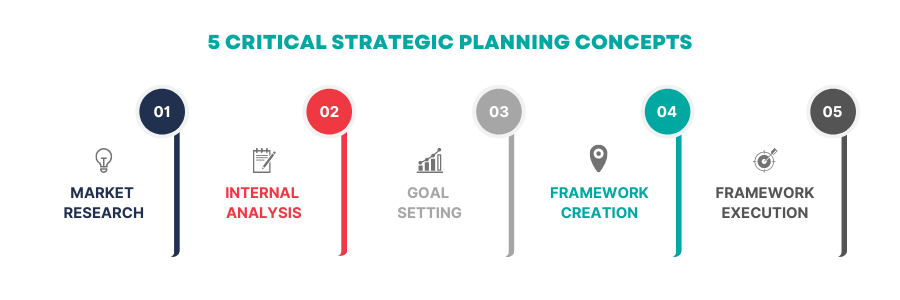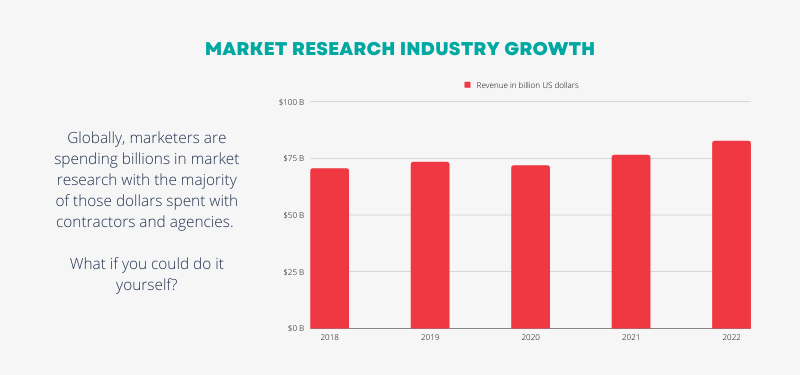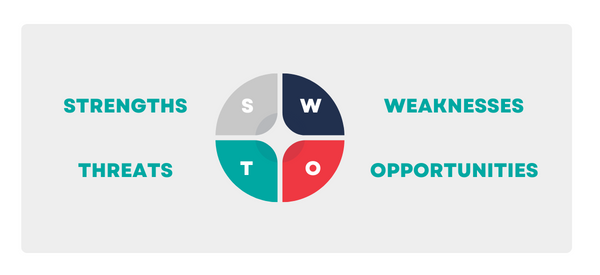5 Critical Strategic Planning Concepts You Need to Know
If you’ve found yourself wondering, “What are strategic planning concepts, anyway?” or, “Is having a strategic plan even necessary?” you’re in the right place.
For organizations big and small the strategic planning process involves the implementation of critical strategic concepts. It’s these concepts that help businesses achieve both their short term and long term organizational goals.
Let’s look at some of the critical concepts needed to help drive an effective strategic planning process:

Market Research
In order to best position yourself within your industry you not only need an in depth understanding of the business environment in which your customer and fellow business colleagues exist, you need to gather tangible data. With enough data, a story will begin to take shape in the form of key insights. These insights can be used to being building the foundation of your strategic plan. Unfortunately, many organizations either fail to collect relevant data or choose not to use the data they collect, which is a missed opportunity to identify important information about themselves and their competitors (such as opportunities and threats, which we’ll talk about further in a moment.)
Of course, it’s important to determine what type of data and information you want to identify. What data points from what specific area of your business would be most beneficial to your long term growth? Through market research, you can gain valuable insight about market opportunities, customer preferences and motivations, market segmentation, product pricing, brand perceptions, and a variety of other important considerations. By answering key questions such as:
- Who is the target market?
- How do customers perceive competitive offerings?
- What are customer behaviors and attitudes?
- What are optimal pricing strategies?
Companies leverage market research findings to help determine the most appropriate course of action for improving market position and boosting sales or profits.
A few ways to begin researching your target market include:
- Focus groups
- B2B surveys
- Customer surveys
- Internal/external stakeholder research

Internal Analysis
Another critical strategic planning concept is evaluating the internal workings of your organization. One of the most effective ways to do this is via a SWOT analysis.
SWOT stands for:
- Strengths. Attributes and areas in which you are currently succeeding. An example here may be your current competitive advantages.
- Weaknesses. Areas in which you could improve and detract from your strengths. To adequately determine weaknesses you may ask questions like, “is there a business process that’s misaligned with the company vision,” or “what gaps exist in skills, knowledge, tools, or manpower.”
- Opportunities. External factors that exist within your business environment that can help you achieve your goals. You may ask if there are upcoming events that your organization’s participation can benefit from.
- Threats. External factors which you have no control over, however should be considered and planned for. Potential threats could be market competition, shifts in technology or consumer behavior.
When done correctly, a SWOT analysis can help you objectively evaluate your organization so you have a better idea of the goals you want to work toward for the future. When used in conjunction with your market research, you can leverage both your strengths (and your weakness) to gain an edge in the market.

To be truly successful with this is an exercise you’ll want to involve your entire company or organization. Honest communication is key here. A SWOT analysis requires true objectivity, and to achieve this you’ll need the perspectives of multiple people who perform different roles within the organization, not solely leadership and stakeholders (although their participation and insight is critical).
Goal Setting
Once you’ve gathered valuable data both internally and externally, it’s necessary to develop goals and objectives. These goals should be SMART, or in other words:
- Specific. To effectively meet your objectives, it’s important to be as specific as possible with your goals, which means answering all the W’s (who, what, when, where, and why)
- Measurable. For this one, you’re gonna need metrics. Determine what you’ll use to measure your progress and the timeline in which you plan to track it.
- Achievable. Ask yourself if your goal is realistic and if you currently have the skills, tools, and/or resources to accomplish the goal.
- Relevant. This is all about alignment. Your goal should meet your overall business objectives. So, for example, if your market research uncovered a gap in your product offerings and your goal is focused on a branding overhaul, you may want to revisit your strategic goals.
- Timely. You can set both short term and long term goals, but the important part is sticking to your timeframe. Be realistic about what direction you’ll need to take and if it’s possible to accomplish the goal within the desired allotment of time.
Framework Creation
So much of the strategic planning process happens in stages and often takes the form of a “brain dump.” Throughout the process, you’ll want to dedicate a person (or two) to overseeing the strategic management and to document the information. Once you have all your high-level business planning information, you’ll need a written framework that captures the strategy in full.
This will include your:
- Company vision
- Mission statement
- Key goals and milestones
- Financial planning
- An action plan that includes dedicated resources and employees that guide weekly, monthly, and yearly actions
If interested, we have created a framework that’s ready for your team to use and will guide you through the strategic planning process whether you are a start-up with a brand new idea, an SMB looking to grow existing verticals, or even a non-profit needing help identifying gaps in your process that are keeping you from achieving your goals.
Framework Execution
Last, but not least, you’ll need to execute your plan. To ensure success, it’s critical that all employees and team members understand their roles and responsibilities as it applies to the business strategy. Make sure to set clear goals and communicate with your team often so they understand how their day-to-day workload fits into the long term plan.
Make sure leadership and key stakeholders review and discuss goals and objectives regularly to ensure continued alignment. Throughout the implementation process, you’ll need to monitor progress, provide performance feedback, course correct, and offer support as needed.
Keep in mind, your strategic plan is not a static document… it’s a living, breathing feat of collaboration and it may require some redirection here and there. That’s okay — most importantly, you want to remember the vision you have for your organization and the goals you have for the future. While, some elements of the plan may need to shift, consistency is key to long-term strategic success.





